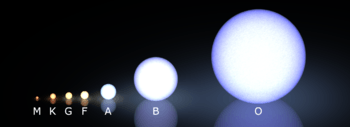HD 9986
| Observation data Epoch J2000 Equinox J2000 | |
|---|---|
| Constellation | Pisces |
| Right ascension | 01h 37m 40.87964s[1] |
| Declination | +12° 04′ 42.1742″[1] |
| Characteristics | |
| Spectral type | G5V [2] |
| Details | |
| Mass | 1.02 [2] M☉ |
| Temperature | 5749 [3] K |
| Metallicity [Fe/H] | +0.09 ± 0.04 [2] dex |
| Age | 4.3 [4] Gyr |
| Other designations | |
| Database references | |
| SIMBAD | data |
| Data sources: | |
| Hipparcos Catalogue | |
HD 9986 is a Sun-like star 84 light years (25.733 parsecs) from the Sun. HD 9986 is a G-type star and a near solar twin[5][6] A speckle survey of G-dwarfs by Elliott P. Horch in 2002 noted that HD 9986 may not be non-single star.[3]
Sun comparison
This chart compares the sun to HD 9986.
| Identifier | J2000 Coordinates | Distance (ly) |
Stellar Class |
Temperature (K) |
Metallicity (dex) |
Age (Gyr) |
Notes | |
|---|---|---|---|---|---|---|---|---|
| Right ascension | Declination | |||||||
| Sun | — | — | 0.00 | G2V | 5,778 | +0.00 | 4.6 | [7] |
| HD 9986 [8] | 01h 37m 40.9s | +12° 04′ 42″ | 84 | G5V | 5749 | +0.09 | 4.3 | [9][4] |
To date no solar twin with an exact match as that of the Sun has been found, however, there are some stars that come very close to being identical to that of the Sun, and are such considered solar twins by the majority of the public. An exact solar twin would be a G2V star with a 5,778K temperature, be 4.6 billion years old, with the correct metallicity and a 0.1% solar luminosity variation.[10] Stars with an age of 4.6 billion years are at the most stable state. Proper metallicity and size are also very important to low luminosity variation. [11][12][13]

References
- 1 2 "HD 9986 – Star". SIMBAD. Centre de données astronomiques de Strasbourg. Retrieved July 13, 2016.
- 1 2 3 "Stellar magnetism: empirical trends with age and rotation," (PDF). Royal Astronomical Society. Cornell University - Astronomy & Astrophysics manuscript. Retrieved July 13, 2016.
- 1 2 "Contributions to the Nearby Stars (NStars) Project: Spectroscopy of Stars Earlier than M0 within 40 parsecs: The Northern Sample I.," (PDF). cds.cern.ch. Cornell University - Astronomy & Astrophysics manuscript. Retrieved July 13, 2016.
- 1 2 "A photometric and spectroscopic survey of solar twin stars within 50 parsecs of the Sun page 7 & 11 & 17, December 31, 2013" (PDF). arxiv. Cornell University - Astronomy & Astrophysics manuscript. Retrieved July 13, 2016.
- ↑ "HD 9986". Retrieved 18 April 2016.
- ↑ Skymap, HIP 7585
- ↑ Williams, D.R. (2004). "Sun Fact Sheet". NASA. Retrieved 2009-06-23.
- ↑ HD 9986 at SIMBAD - Ids - Bibliography - Image.
- ↑ Porto de Mello, G. F.; da Silva, R.; da Silva, L.; de Nader, R. V. (March 2014). "A photometric and spectroscopic survey of solar twin stars within 50 parsecs of the Sun; I. Atmospheric parameters and color similarity to the Sun". Astronomy and Astrophysics. 563: A52. arXiv:1312.7571
 . Bibcode:2014A&A...563A..52P. doi:10.1051/0004-6361/201322277.
. Bibcode:2014A&A...563A..52P. doi:10.1051/0004-6361/201322277. - ↑ NASA, Science News, Solar Variability and Terrestrial Climate, Jan. 8, 2013
- ↑ University of Nebraska-Lincoln astronomy education group, Stellar Luminosity Calculator
- ↑ National Center for Atmospheric Research, The Effects of Solar Variability on Earth's Climate, 2012 Report
- ↑ Most of Earth’s twins aren’t identical, or even close!, by Ethan on June 5, 2013